Kawasaki ER-6f ABS 2013 Owner's manual
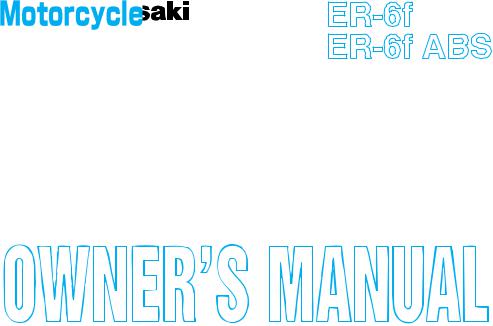
ER-6f
ER-6f ABS
Free
Download
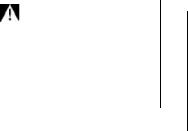
Whenever you see the symbols shown below, heed their instructions! Always follow safe operating and maintenance practices.
NOTE
 This note symbol indicates points of particular interest for more efficient and convenient operation.
This note symbol indicates points of particular interest for more efficient and convenient operation.
|
|
.org |
|
WARNING |
|||
|
NOTICE |
||
This warning symbol identifies |
|
||
|
|
||
.ClassicCycles |
|||
special instructions or proce- |
|
THIS PRODUCT HAS BEEN |
|
dures which, if not correctly fol- |
|
MANUFACTURED FOR USE IN A |
|
lowed, could result in personal |
|
REASONABLE AND PRUDENT |
|
injury, or loss of life. |
|
MANNER BY A QUALIFIED OP- |
|
|
|
ERATOR AND AS A VEHICLE |
|
|
|
ONLY. |
|
CAUTION |
|
|
|
|
|
||
This caution symbol identifies |
|
|
|
special instructions or proce- |
|
|
|
www |
|
|
|
dures which, if not strictly ob- |
|
|
|
served, could result in damage |
|
|
|
to or destruction of equipment. |
|
|
|
FOREWORD
Congratulations on your purchase of a new Kawasaki motorcycle. Your new motorcycle is the product of Kawasaki s advanced engineering, exhaustive testing, and continuous striving for superior reliability, safety and performance.
Please read this Owner s Manual carefully before riding so that you will be thoroughly familiar with the properFreeoperation of your motorcycle s controls, its features, capabilities, and limitations. This manual offers many safe riding tips, but its purpose is not to provide instruction in all the techniques and skills required to ride
a motorcycle safely. Kawasaki strongly recommends that all operators of this vehicle enroll in a motorcycle rider trainingDownloadpr gram to attain awareness of the mental and physical requirements necessary for safe motorcycle operation.
To ensure a long, trouble-free life for your motorcycle, give it the proper care and maintenance described in this manual. For those who would like more detailed information on their Kawasaki Motorcycle, a Service M nual is available for purchase from any authorized Kawasaki motorcycle dealer. The Service Manual contains detailed disassembly and maintenance information. Those who plan to do their own work should, of course, be competent mechanics and possess the special tools described in the Service Manual.
Keep this Owner s Manual aboard your motorcycle at all times so that you can refer to it whenever you need information.

TABLE OF CONTENTS
SPECIFICATIONS............................... |
|
8 |
Fuel Tank Cap.................................. |
||
LOCATION OF PARTS ....................... |
|
12 |
Fuel Tank |
.......................................... org |
|
.................GENERAL INFORMATION |
15 |
Fuel Requirement: ........................ |
|||
Meter Instruments ............................ |
|
15 |
Stand................................................ |
|
|
Left Handlebar Switches ............ |
. |
ClassicCycles27 Moving Off........................................ |
|||
Speedometer and Tachometer: .... |
16 |
Seat Lock ......................................... |
|
||
LCD (Clock, Odometer, Trip |
|
Helmet Holding ......................Cable |
|||
Meters): ..................................... |
|
17 |
Tool Kit/U-Shaped lock |
||
Warning/Indicator Lights: .............. |
21 |
Compartment................................ |
|||
Key................................................... |
|
23 |
Tying Hooks ..................................... |
||
Ignition Switch/Steering Lock........... |
24 |
BREAK-IN........................................... |
|
||
Right Handlebar Switches................ |
25 |
HOW TO RIDE THE MOTORCYCLE . |
|||
Engine Stop Switch: ..................... |
|
25 |
Starting the ..........................Engine |
||
Starter Button: .............................. |
www |
26 |
Jump Starting................................... |
||
Dimmer Switch: |
27 |
Shifting Gears |
|||
|
|||||
Turn Signal Switch:....................... |
|
28 |
Braking............................................. |
|
|
Horn Button: ................................. |
|
28 |
Anti-lock Brake System (ABS) for |
||
Passing Button: ............................ |
|
28 |
models ...........equipped with ABS |
||
Hazard Switch: ............................. |
|
28 |
ABS Indicator ......................Light: |
||
Brake/Clutch Lever Adjusters........... |
29 |
Stopping the .........................Engine |
|||
30
31
32
33
34
36
37
38
39
41
41
43
45
46
47
49
50
51
Stopping the Motorcycle in an |
|
Engine Vacuum Synchronization ..... |
86 |
|
Emergency ................................... |
|
52 |
Idle Speed........................................ |
86 |
Parking............................................. |
|
53 |
Clutch............................................... |
88 |
Catalytic Converter........................... |
|
54 |
Drive Chain ...................................... |
90 |
SAFE OPERATION............................. |
|
56 |
Brakes.............................................. |
98 |
Daily Safety Checks......................... |
|
56 |
Brake Light Switches........................ |
102 |
Additional Considerations fo |
High |
|
Front Fork......................................... |
104 |
Speed Operation .......................... |
|
58 |
Rear Shock Absorbers..................... |
105 |
MAINTENANCE AND ADJUSTMENTFree |
60 |
Wheels ............................................. |
107 |
|
Periodic Maintenance Chart............. |
|
61 |
Battery.............................................. |
112 |
Air Cleaner ....................................... |
Download83 ENVIRONMENTAL PROTECTION..... |
129 |
||
Engine Oil ........................................ |
|
70 |
Headlight Beam................................ |
117 |
Cooling System................................ |
|
75 |
Rear Turn Signal Light ..................... |
119 |
Spark Plugs...................................... |
|
80 |
Fuses ............................................... |
119 |
Kawasaki Clean Air System............. |
|
82 |
Cleaning Your Motorcycle ................ |
121 |
Valve Clearance............................... |
|
83 |
STORAGE........................................... |
126 |
Throttle Control System ................... |
|
84 |
LOCATION OF LABELS..................... |
130 |
8 SPECIFICATIONS
|
|
SPECIFICATIONS |
|
|
||
PERFORMANCE |
|
|
|
|||
|
|
|
|
|
|
|
Maximum Horsepower |
|
|
|
53 kW (72 PS) @8 500 r/min (rpm) |
||
Maximum Torque |
|
|
|
|
.org |
|
|
|
|
66 N·m (6.7 kgf·m, 48.7 ft·lb) |
|||
|
|
.ClassicCycles |
||||
|
|
|
|
@7 000 r/min (rpm) |
|
|
Minimum Turning Radius |
|
2.7 m (106.3 in.) |
|
|
||
DIMENSIONS |
|
|
|
|
|
|
Overall Length |
|
|
|
2 105 mm (82.87 in.) |
||
Overall Width |
|
|
|
760 mm (29.92 in.) |
|
|
Overall Height |
|
|
|
1 210 mm (47.64 in.) |
||
Wheelbase |
www |
|
1 410 mm (55.51 in.) |
|||
Road Clearance |
|
145 mm (5.71 in.) |
|
|
||
|
|
|
|
|
||
Dry Weight |
|
|
(A) |
178 kg (392 lb) |
|
|
|
|
|
(B) |
182 kg (401 lb) |
|
|
ENGINE |
|
|
|
|
|
|
Type |
|
|
|
DOHC, 4-valve, 2-cylinder, 4-stroke, liquid-cooled |
||

|
|
|
SPECIFICATIONS 9 |
Displacement |
|
|
649 cm3 (39.6 cu in.) |
Bore x Stroke |
|
|
83 x 60 mm (3.27 x 2.36 in.) |
Compression Ratio |
|
|
11.3 : 1 |
Starting System |
|
|
Electric starter |
Cylinder Numbering Method |
|
Left to right, 1-2 |
|
Firing Order |
Free |
1-2 |
|
|
|
||
Carburetion System |
|
|
Fi (Fuel Injection) |
Lubrication System |
|
DownloadForced lubrication (semi-dry sump) |
|
Ignition System |
|
|
Battery and coil (transistorized ignition) |
Ignition Timing |
|
|
10° BTDC @1 300 r/min (rpm) |
(Electronically advanced) |
|
35° BTDC @4 800 r/min (rpm) |
|
Spark Plugs |
|
|
NGK CR9EIA-9 |
Engine Oil |
Type : |
|
API SE, SF or SG |
|
|
|
API SH, SJ or SL with JASO MA |
|
|
|
SAE 10W-40 |
|
Capacity : 2.4 L (2.5 US qt) |
||
Coolant Capacity |
|
|
1.2 L (1.3 US qt) |
10 SPECIFICATIONS |
|
|
|
|
|
TRANSMISSION |
|
|
|
|
|
Transmission Type |
|
|
6-speed, return shift |
|
|
Clutch Type |
|
|
Wet, multi disc |
.org |
|
Driving System |
|
|
Chain drive |
||
Primary Reduction Ratio |
|
2.095 (88/42) |
|||
Final Reduction Ratio |
5th |
.ClassicCycles0.966 (28/29) |
|||
|
|
3.067 |
(46/15) |
|
|
Overall Drive Ratio |
|
|
5.473 |
(Top gear) |
|
Gear Ratio |
1st |
|
2.438 |
(39/16) |
|
|
2nd |
|
1.714 |
(36/21) |
|
|
3rd |
|
1.333 |
(32/24) |
|
|
4th |
|
1.111 (30/27) |
|
|
|
www |
0.852 |
(23/27) |
|
|
|
6th |
|
|
||
FRAME |
|
|
|
|
|
Castor |
|
|
25° |
|
|
Trail |
|
|
106 mm (4.2 in.) |
|
|
Tire Size: |
Front |
|
120/70ZR17 M/C (58 W) Tubeless |
||
|
Rear |
Rim Size: |
Front |
|
Rear |
Fuel Tank Capacity
ELECTRICAL EQUIPMENT |
|
Battery |
Free |
|
|
Headlight
SPECIFICATIONS 11
160/60ZR17 M/C (69 W) Tubeless 17 × 3.50 17 × 4.50
15.5 L (4.1 US gal)
12 V 10 Ah
12 V 55 W / 55 W (Hi/Lo)
Tail/Brake Light |
Download |
12 V 5/21 W |
(A): EX650A
(B): EX650B
Specifications subject to change without notice, n may not apply to every country.
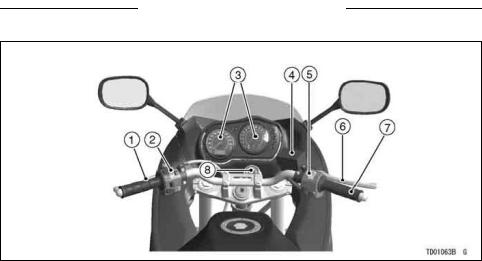
12 LOCATION OF PARTS
LOCATION OF PARTS
|
|
|
|
|
.org |
|
|
|
.ClassicCycles |
||
1. |
Clutch Lever |
www |
5. |
Right Handlebar Switches |
|
2. |
Left Handlebar Switches |
|
6. |
Front Brake Lever |
|
3. |
Meter Instruments |
|
|
7. |
Throttle Grip |
4. |
Brake Fluid Reservoir (Front) |
|
8. |
Ignition Switch/Steering Lock |
|
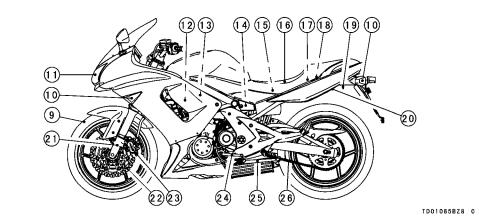
LOCATION OF PARTS 13
|
|
Free |
|
|
|
|
|
Download |
|
|
|
9. |
Wheel |
16. |
Seat |
22. |
Brake Disc |
10. |
Turn Signal Light |
17. |
Tool Kit/Storage |
23. |
Brake Caliper |
11. |
Headlight |
18. |
Compartments |
24. |
Shift Pedal |
12. |
Spark Plugs |
Helmet Holding Cable |
25. |
Side Stand |
|
13. |
Air Cleaner |
19. |
Tying Hooks |
26. |
Drive Chain |
14. |
Main Fuse |
20. |
Seat Lock |
|
|
15. |
Battery |
21. |
Front Fork |
|
|
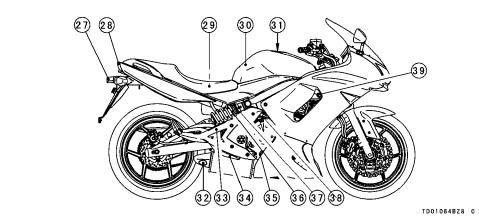
14 LOCATION OF PARTS
|
|
|
|
.org |
|
|
|
|
|
|
ClassicCycles |
|
|
|
|
|
|
|
. |
|
|
|
|
27. |
License Plate Light |
www |
Muffler |
37. |
Rebound Damping |
||
|
32. |
||||||
28. |
Tail/Brake Light |
|
33. |
Rear Brake Light |
38. |
Force Adjuster |
|
29. |
Brake Fluid Reservoir |
34. |
Switch |
Idle Adjusting Screw |
|||
30. |
(Rear) |
|
Rear Brake Pedal |
39. |
Coolant Reserve Tank |
||
Fuel Tank |
|
35. |
Oil Level Gauge |
|
|
|
|
31. |
Fuel Tank Cap |
|
36. |
Rear Shock Absorber |
|
|
|

GENERAL INFORMATION 15
GENERAL INFORMATION
Meter Instruments
A.Speedometer
B.Left Turn Signal Indicator
C.Tachometer Free
D.Red Zone
E.Right Turn Signal IndicatorLight
Light |
Download |
F. High Beam Indicator Light |
|
G. Neutral Indicator Light |
|
H. Oil Pressure Warning Light |
|
I. RESET Button |
|
J. FI Indicator Light |
|
K. ABS Indicator Light (model |
|
with ABS) |
|
L. Fuel Level Warning Light |
|
M. MODE Button |
|
N. Coolant Temperature |
|
Warning Light |
|
O. LCD Display (Clock, Trip |
|
Meter A/B, Odometer) |
|

16 GENERAL INFORMATION |
|
|
Speedometer and Tachometer: |
readings to check their operation. If the |
|
The speedometer shows the speed |
speedometer and tachometer needles |
|
of the vehicle. |
do not operate correctly, have them |
|
The tachometer shows the engine |
inspected by an authorized Kawasaki |
|
speed in revolutions per minute (r/min, |
dealer. |
|
rpm). On the right side of the tachome- |
|
|
.CAUTIONorg |
||
ter face is a portion called the "red |
||
.ClassicCycles |
||
zone". Engine r/min (rpm) in the |
Engin r/min (rpm) should not |
|
red zone is above maximum recom- |
be allowed to enter the red zone; |
|
mended engine speed and is also |
operation in the red zone will |
|
above the range for good performance. |
overstress the engine and may |
|
When ignition key is turned to ON , |
cause serious engine damage. |
|
the speedometer and tachometer nee- |
|
|
|
||
dles momentarily point to their last |
|
|
www |
|
|
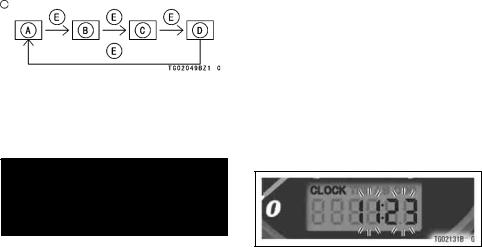
|
|
|
GENERAL INFORMATION 17 |
|
LCD (Clock, Odometer, Trip Meters): |
NOTE |
|||
The speedometer face contains the |
For safe operation do not press the |
|||
LCD (Liquid Crystal Display ). Pushing |
MODE button while riding. |
|||
the MODE button, shifts the display |
|
|||
through the following four modes: |
Clock - |
|||
Clock, Odometer, Trip meter A/B. |
||||
To adjust the hours and minutes: |
||||
When the ignition key is turned to ON , |
Turn the ignition key to "ON". |
|||
all the LCD segments are displayed for |
||||
three seconds, then theFreeclock or me- |
Push the "MODE" button to display |
|||
ters, depending on the mode selected, |
the clock. |
|||
Push the "RESET" button for more |
||||
will operate normally on the mode se- |
||||
lected. |
|
|
than two seconds. Both the hour and |
|
|
|
minute displays start flashing. |
||
|
Download |
|||
|
|
|
|
|
A.Clock
B.Odometer
C.Trip Meter A
D.Trip Meter B
E.Push MODE Button
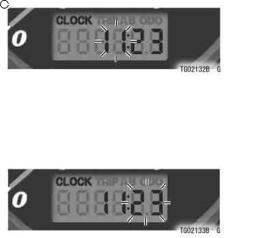
18 GENERAL INFORMATION |
|
Push the "RESET" button. Both the |
|||
Push |
the "RESET" button. |
The |
|||
|
hour |
display only flashes. |
Push |
hour and minute displays start flash- |
|
|
the "MODE" button to advance the |
ing again. |
|
||
|
hours. |
|
Push the "MODE" button. The dis- |
||
|
|
|
|
.org |
|
|
|
|
|
plays stop flashing and the clock |
|
|
|
|
. |
starts working. |
|
|
|
|
ClassicCyclesswitch is turned off. |
||
|
|
|
|
NOTE |
|
|
|
|
|
Pushing the MODE button momen- |
|
|
Push |
the "RESET" button. |
The |
tarily advances the hour or minute |
|
|
step by step. |
Pushing and hold- |
|||
hour display stops flashing and the |
ing the button advance the hour or |
||||
|
minute display starts flashing. Push |
minute continuously. |
|||
|
the "MODE" button to advance the |
The clock works normally from the |
|||
|
minutes. |
|
back-up power |
while the ignition |
|
|
|
|
|
||
|
|
|
|
|
|
|
|
www |
When the battery is disconnected, |
||
|
|
|
|
||
|
|
|
|
the clock resets to 1:00 and starts |
|
|
|
|
|
working again when the battery is |
|
|
|
|
|
connected. |
|
|
|
|
|
|
|
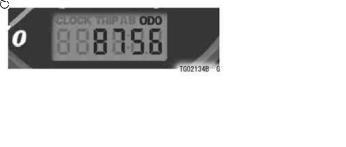
|
|
|
|
GENERAL INFORMATION 19 |
||
Odometer - |
|
|
|
Trip Meter - |
|
|
The odometer shows the total dis- |
The trip meters show the distance in |
|||||
tance the vehicle has been ridden. This |
kilometers traveled since they were last |
|||||
meter cannot be reset. |
|
|
|
reset to zero. |
|
|
|
|
|
|
TRIP A: 0.0 |
999.9 |
|
|
|
|
|
|||
|
Free |
|
TRIP B: 0.0 |
9999.9 |
||
|
|
To reset the trip meter: |
||||
|
|
Push the MODE button to display |
||||
|
|
the trip meter A or B. |
||||
|
|
|
|
Push the RESET button and hold it |
||
NOTE |
|
|
|
|||
|
|
|
in. |
|
||
The data is maintained even if the |
After two seconds, the figure display |
|||||
battery is disconnected. |
|
|
turns to 0.0, and then starts counting |
|||
|
|
when the vehicle is operated. The |
||||
When the figures come to 999999, |
||||||
meter counts until it is next reset. |
||||||
they are stopped and locked. |
||||||
|
|
Download |
|
|||
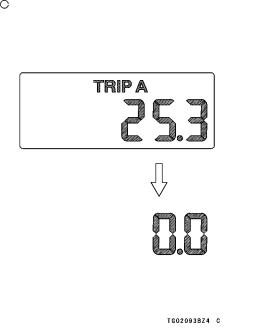
20 GENERAL INFORMATION
|
NOTE |
|
|
|
The data is maintained by the back |
|
-up power if the ignition key is turned |
|
off. |
|
.org |
|
When the trip meter is reset while the |
|
vehicle is st pped, it starts counting |
|
ClassicCycles |
|
as soon a the vehicle starts moving. |
|
When th trip meter reaches 999.9 |
|
(TRIP A) or 9999.9 (TRIP B) while |
|
running, the meters reset to 0.0 and |
|
ontinues counting. |
|
When the battery is disconnected, |
|
the meter display resets to 0.0. |
. |
|
www |
|
|
|
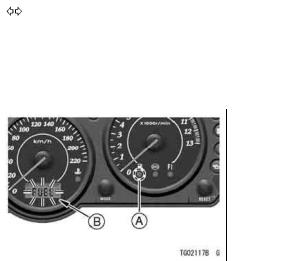
|
|
|
|
|
|
|
|
GENERAL INFORMATION 21 |
Warning/Indicator Lights: |
|
|
|
NOTE |
||||
|
|
: The fuel level warning light in |
|
When pushing the MODE button |
||||
the tachometer goes on and FUEL |
|
while FUEL is displayed, the dis- |
||||||
flashes in the LCD when only 3.5 L |
|
play can be shifted to odometer, trip |
||||||
(0.9 US gal) of fuel remains. Refuel at |
|
meter, or clock mode. |
||||||
the earliest opportunity when the fuel |
N: When the transmission is in neutral, |
|||||||
|
|
|
Free |
|||||
level warning light goes on and FUEL |
the neutral indicator light is lit. |
|||||||
flashes. |
|
|
||||||
|
|
|
|
|
|
|||
|
|
|
|
|
|
|
|
: When the headlight is on high |
|
|
|
Download |
|||||
|
|
|
|
|
beam, the high beam indicator light is |
|||
|
|
|
|
|
lit. |
|||
|
|
|
|
|
|
|
: When the turn signal switch is |
|
|
|
|
|
|
pushed to the left or right, the cor- |
|||
|
|
|
|
|
responding turn signal indicator light |
|||
|
|
|
|
|
flashes. |
|||
|
|
|
|
|
|
|
|
|
A.Fuel Level Warning Light
B.Flash
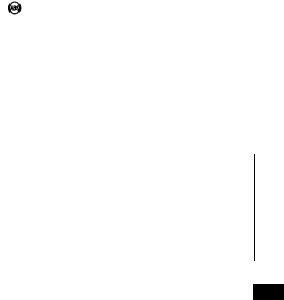
22 GENERAL INFORMATION |
|
|
|
||
|
|
: The coolant temperature warning |
|||
|
: The oil pressure warning light |
|
|||
goes on whenever the oil pressure is |
light in the speedometer goes on when- |
||||
dangerously low or the ignition key is |
ever the coolant temperature rises to |
||||
in the ON position with the engine not |
115°C (239°F) when the motorcycle is |
||||
running, and goes off when the engine |
in operation. This warns the operator |
||||
oil pressure is high enough. Refer to |
that the coolant temperature is too high. |
||||
the Maintenance and Adjustment chap- |
|
.org |
|||
If the warning light goes on, stop the |
|||||
ter for more detailed engine oil informa- |
engine and check the coolant level in |
||||
tion. |
|
the reserve tank after the engine cools |
|||
FI: The fuel injection (FI) indicator light |
down. |
|
|||
|
|
|
|||
|
|
CAUTION |
|||
in the tachometer goes on when the ig- |
|
|
|||
nition key is turned to ON and goes off |
Do not let the engine continue |
||||
soon after ensuring that its circuit func- |
running when the warning light |
||||
tions properly. The indicator light also |
flashes. Prolonged engine oper- |
||||
goes on whenever the troubles.occurClassicCycles |
|
||||
in digital fuel injection system (DFI). If |
ation will result in severe dam- |
||||
age from overheating. |
|||||
the indicator light comes on, have the |
|
|
|
||
|
|
|
|||
DFI system checked by an authorized |
(For models equipped with ABS) |
||||
Kawasaki dealer, |
www |
|
: The ABS (Anti-lock Brake Sys- |
||
|
|
||||
When the indicator light flashes, first |
tem) indicator light in the tachometer |
|
turn the ignition key to OFF and then |
||
comes on when the ignition switch is |
||
back to ON . |
||
|
|
|
|
GENERAL INFORMATION 23 |
turned on and goes off shortly after the |
Key |
||
motorcycle starts moving. |
If the ABS |
This motorcycle has a combination |
|
is normal, it stays off. |
If |
something |
key, which is used for the ignition |
is wrong with the ABS, the indicator |
switch/steering lock, seat lock, and fuel |
||
comes on and remains lit. |
When the |
tank cap. |
|
indicator light is on, the ABS does not |
Blank keys are available at your |
||
function but if the ABS fails, the con- |
Kawasaki dealers. Ask your dealer to |
||
ventional brake system will still work |
make any additional spare keys you |
||
normally. |
Free |
may need, using your original key as a |
|
For more detailed information about |
master. |
||
|
|
Download |
|
ABS, see the Anti-lock Brake System (ABS) section in the How to Ride the Motorcycle chapter.
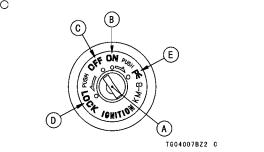
24 GENERAL INFORMATION
Ignition Switch/Steering Lock |
OFF |
Engine off. |
All electrical |
||||
This is a four-position, key-operated |
circuits off. |
|
|||||
|
|
||||||
switch. The key can be removed from |
|
|
|
||||
ON |
Engine on. |
All electrical |
|||||
the switch when it is in the OFF, LOCK, |
|||||||
equipment can be used. |
|||||||
or P (Park) position. |
|
|
|
|
|
|
|
|
|
|
LOCK |
Stee ing locked. Engine off. |
|||
|
|
|
|
||||
|
|
|
|
All electrical circuits off. |
|||
|
|
|
|
|
|||
|
|
|
|
|
.org |
|
|
|
|
|
|
|
Steering locked. Engine off. |
||
|
|
|
|
P(Park) |
License plate, tail, and city |
||
|
|
|
|
lights on and turn signals can |
|||
|
|
|
|
|
be used. All other electrical |
||
|
|
|
|
|
circuits cut off. |
||
|
|
|
|
|
NOTE |
||
|
|
. |
|
The city, tail and license plate lights |
|||
|
|
ClassicCyclesare on whenever the ignition key is |
|||||
A. Ignition Switch/Steering Lock |
|
||||||
|
|
in the ON position. One headlight |
|||||
B. ON position |
www |
goes on when the starter button is |
|||||
C. OFF position |
|||||||
released after starting the engine. To |
|||||||
D. LOCK position |
|||||||
E. P (Park) position |
avoid battery discharge, always start |
||||||
|
|
|
|||||
the engine immediately after turning the ignition key to ON .

|
|
|
|
GENERAL INFORMATION 25 |
||
If you leave the P (Park) position on |
Right Handlebar Switches |
|||||
for a long time (one hour), the battery |
Engine Stop Switch: |
|
||||
may become totally discharged. |
In addition to the ignition switch, |
|||||
|
|
the engine stop switch must be in |
||||
|
|
the |
|
position for the motorcycle to |
||
Free |
|
operate. |
|
|
|
|
|
The engine stop switch is for emer- |
|||||
|
|
|||||
|
|
gency use. If some emergency re- |
||||
|
|
quires stopping the engine, move the |
||||
Download |
|
|
position. |
|||
|
|
engine stop switch to the |
|
|||
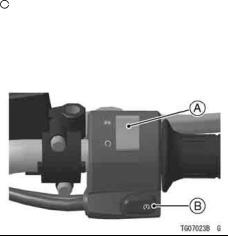
26 GENERAL INFORMATION |
|
|
|
|
NOTE |
|
|
|
Starter Button: |
Although the engine stop switch |
The starter button operates the elec- |
|||
stops the engine, it does not turn off |
tric starter when the transmission is in |
|||
all the electrical circuits. Ordinarily, |
neutral. |
|||
the ignition switch should be used to |
.org |
|||
Refer to the Sta ting the Engine sec- |
||||
stop the engine. |
|
|
|
tion of the "H w to Ride the Motorcycle" |
|
|
ClassicCycles |
||
|
|
|
|
chapter for tarting instructions. |
|
. |
|
|
|
|
www |
|
|
|
A. Engine Stop Switch |
|
|
|
|
B. Starter Button

|
|
|
|
|
|
|
|
|
GENERAL INFORMATION 27 |
Left Handlebar Switches |
NOTE |
||||||||
Dimmer Switch: |
|
|
|
|
|
|
When the headlight is on high beam, |
||
High or low beam can be selected |
both head lights are lit. When the |
||||||||
with the dimmer |
switch. |
When |
the |
headlight is on low beam, only one |
|||||
headlight is on high beam ( |
|
), the |
headlight is lit. |
||||||
|
|||||||||
high beam indicator light is lit. |
|
||||||||
High beam.......( |
|
|
|
) |
Free |
|
|||
|
|
|
|
|
|
|
|||
|
|
|
|
|
|
|
|||
Low beam.......( |
|
|
) |
|
|
|
|
||
|
|
|
|
|
|
|
Download |
||
|
|
|
|
|
|
|
|
|
|
|
|
|
|
|
|
|
|
|
A. Dimmer Switch |
B. Turn Signal Switch
C. Horn Button
D. Passing Button
E. Hazard

28 GENERAL INFORMATION |
|
|
|
|
|
|||
Turn Signal Switch: |
|
|
hazard lights to warn other drivers of |
|||||
When the turn signal switch is turned |
your location. |
|
||||||
to the left ( |
|
|
) or right ( |
|
), the |
Push in the hazard switch with the |
||
corresponding |
turn signal flashes on |
ignition switch in the ON or P (Park) |
||||||
and off. |
|
|
|
|
|
.org |
||
|
|
|
|
position. All the turn signals and turn |
||||
To stop flashing, push the switch in. |
signal indicat r lights will flash on and |
|||||||
|
|
|
|
|
ClassicCycles |
|
||
Horn Button: |
|
|
|
|
off. |
|
|
|
When the horn button is pushed, the |
|
|
CAUTION |
|||||
horn sounds. |
|
|
|
|
If you leave the switch on for a |
|||
Passing Button: |
|
|
long time, the battery may be- |
|||||
When the passing button is pushed, |
come totally discharged. So be |
|||||||
the headlight high beam (passing |
careful not to use the hazard |
|||||||
beam) comes on to signal the driver of |
lights for more than 30 minutes. |
|||||||
the vehicle ahead that you are about to |
|
|
|
|||||
|
|
|
||||||
pass him. The passing light shuts. off |
|
|
|
|||||
as soon as the button is released. |
|
|
|
|||||
Hazard Switch: |
|
|
|
|
|
|||
If an emergency requireswwwyou to park |
|
|
|
|||||
on the highway shoulder, turn on the |
|
|
|
|||||
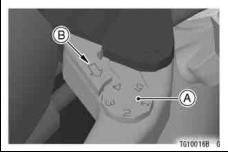
|
|
GENERAL INFORMATION 29 |
||
Brake/Clutch Lever Adjusters |
The distance from the grip to the re- |
|||
There is an adjuster on both the |
leased lever is minimum at Number 5 |
|||
brake and clutch levers. Each adjuster |
and maximum at Number 1. |
|||
has 5 positions so that the released |
|
|
|
|
|
|
|
||
lever position can be adjusted to suit |
|
|
|
|
the operator s hands. Push the lever |
|
|
|
|
forward and turn the adjuster to align |
|
|
|
|
the number with the arrow mark on the |
|
|
|
|
lever holder. |
Free |
|
|
|
|
Download |
|
|
|
|
|
|||
|
|
A. Adjuster |
||
B. M rk
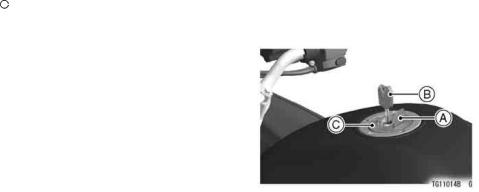
30 GENERAL INFORMATION
Fuel Tank Cap |
NOTE |
|
To open the fuel tank cap, pull up the |
Do not push on the key to close the |
|
key hole cover. Insert the ignition key |
cap, or the cap cannot be locked. |
|
into the fuel tank cap and turn the key |
|
|
to the right. |
|
|
.org |
||
To close the cap, push it down into |
||
place with the key inserted. The key |
||
can be removed by turning it to the left |
|
|
to the original position. |
|
|
NOTE |
|
|
The fuel tank cap cannot be closed |
|
|
without the key inserted, and the key |
|
|
cannot be removed unless the cap is |
|
|
locked properly. |
|
|
A. Key Hole Cover |
||
|
||
.ClassicCycles |
||
www |
B. Ignition Key |
|
C. Fuel Tank Cap |
||
|
||
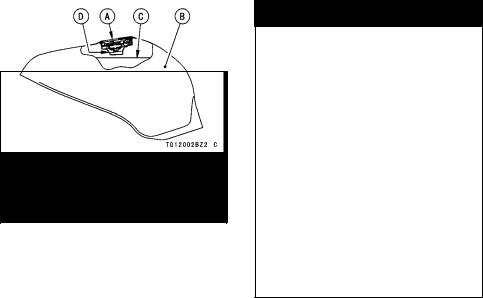
GENERAL INFORMATION 31
 WARNING
WARNING
Gasoline is extremely flammable and can be explosive under certain conditions. Turn the ignition key to OFF . Do not smoke. Make sure the area is well ventilated and free from any source of flame or sparks; this includes
any appliance with a pilot light. DownloadNever fill the tank so the fuel level rises into the filler neck. If
the tank is overfilled, heat may cause the fuel to expand and verflow through the vents in the tank cap.
After refueling, make sure the fuel tank cap is closed securely. If gasoline is spilled on the fuel tank, wipe it off immediately.

32 GENERAL INFORMATION
Fuel Requirement:
Your Kawasaki engine is designed to use only unleaded gasoline.
(RON). Always use a gasoline with an octane rating equal to, or higher than, RON 91.
|
NOTE |
CAUTION |
|
|
If knocking r pinging occurs, use |
|
|
Do not use leaded gasoline, as |
a different.brandorgof gasoline or higher |
. |
ClassicCycles |
this will destroy the catalytic |
octane rating. |
converter. (For further infor- |
|
mation, refer to the Catalytic |
|
Converter section in the How |
|
to Ride the Motorcycle chap- |
|
ter.) |
|
Octane Rating |
|
The octane rating of a gasoline is a |
|
measure of its resistance to detona- |
|
tion or "knocking." The term commonly |
|
used to describe a gasoline s octane |
|
rating is the Research OctanewwwNumber |
|
